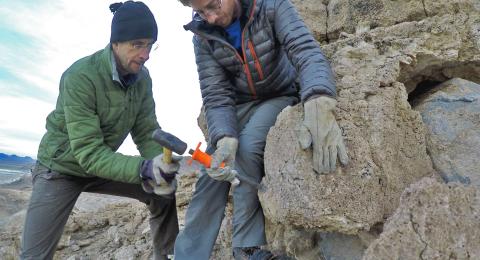SUNY Oswego faculty, students part of effort studying past climate changes in Death Valley, Mohave Desert
Office of Communications and Marketing
Published
A team of researchers from SUNY Oswego and four other colleges and universities recently earned a National Science Foundation grant to study water levels over the last 150,000 years in two of North America's driest places, Death Valley and another dry lakebed in Southern California's Mohave Desert, Searles Lake.
The study will provide refined analysis of past precipitation cycles and other data indicative of climate change, to develop a model to predict future wet-dry eras in the Searles and Death Valley basins, both in close proximity to one of the country's most productive agricultural areas, the Central Valley of California.
SUNY Oswego's Justin Stroup, an atmospheric and geological sciences faculty member, has joined an interdisciplinary group from Binghamton University (the lead institution), Massachusetts Institute of Technology, University of Southern California and Keystone College in Northeastern Pennsylvania.
"We are studying lake levels over the last 150,000 years to explore precipitation variability in Southern California," said Stroup, a hydrologist who has a doctorate from Dartmouth College and conducted post-doctoral work at MIT. "In the past, Searles Lake and Death Valley have not been so dry. At times in the past, these valleys contained giant lakes. By studying these valleys, we have an opportunity to understand past climate changes."
Researchers have been working with core samples -- notably a 250-foot-long core from Searles Lake drilled in 2017 -- to determine precipitation cycles, water volumes, shoreline variations, chemistry, sedimentology, mineralogy, leaf wax and pollen content over the millennia. They're using uranium-thorium dating to determine the precise times of past climate changes, Stroup said.
Student opportunities
Studies of the region in the past have left gaps in the data and there are "confusing indications of the region's hydrological history," the scientists said in an application for the NSF grant. One goal of the current research is to provide proof of concept for grant applications to study 3.2 million year's worth of sediment -- about 2,300 feet in depth -- in the Searles basin, which was part of a chain of five lakes. Stroup said, “these lakes were once connected and may help us to understand the past flow of the Owens River,” which is an essential part of the Los Angeles water supply.
The study, titled "Regional hydrologic and vegetation changes over the last 150 Kyr (150,000 years) in the Searles and Death Valley basins," will involve training and employment of undergraduate researchers from all five higher education institutions and graduate students from the universities.
Besides research and travel in the Southern California desert, students will benefit from training and experience in lab work during the academic year, and Stroup intends to incorporate results of the analyses in his courses on paleoclimate, environmental sustainability and hydrogeology.
Stroup's students, Mary Sorensen and Rebecca Nesel, completed senior projects this spring examining Searles Lake core samples to analyze various protocols for grain size measurement and testing of sediments. With Stroup, Sorensen and Nesel both produced conference papers from the research.
For more information on atmospheric and geological sciences at SUNY Oswego, visit oswego.edu/ags.



